
Larchmont is a village located within the Town of Mamaroneck in Westchester County, New York, approximately 18 miles (29 km) northeast of Midtown Manhattan. The population of the village was 5,864 at the 2010 census. In February 2019, Bloomberg ranked Larchmont as the 15th wealthiest place in the United States, and the third wealthiest in New York.
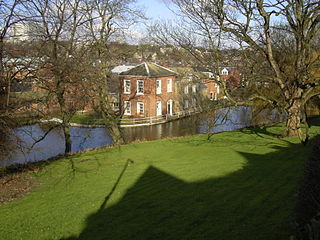
The Porter Brook is a river in the City of Sheffield, England descending over 1,000 feet (300 m) from its source among the sedge grass on Burbage moor behind a small farm on Hangram just inside the Peak District National Park in the west of the city at Clough Hollow, near the village of Ringinglow. Porter Brook derives its name from its brownish colour, similar to the colour of Porter, a brownish discolouration obtained as it passes over iron-ore deposits on its course from the source. Close to the source, at the junction of Fulwood Lane and Greenhouse Lane is a Rotary Club funded toposcope, Finder Cairn.
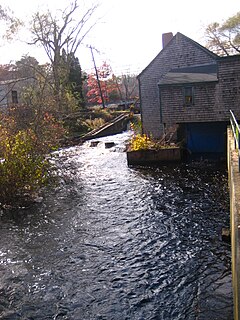
The Jones River is a 7.5-mile-long (12.1 km) river running through Kingston, Massachusetts. The river drains about 30 square miles (78 km2), has its source in Silver Lake and drains into Kingston Bay. Land surrounding the river is 52% forested, of which 22% has been developed for residential use. There is a USGS stream gauge along 16 square miles (41 km2) of the river and it has measured the flow at 0.7 cubic feet per second (0.020 m3/s) per square mile of drainage area.

Pawtuckaway Lake is a 784-acre (3.17 km2) reservoir in Rockingham County in southeastern New Hampshire, United States, in the town of Nottingham. The lake is located in the Piscataqua River drainage basin.

Quaboag Pond is a 537-acre (2.17 km2) pond located near the East Brookfield and Brookfield, Massachusetts. The pond lies about two miles (3 km) south of state Route 9 as it passes through East Brookfield. Quaboag Pond was once named Podunk Pond.

The Presumpscot River is a 25.8-mile-long (41.5 km) river located in Cumberland County, Maine. It is the main outlet of Sebago Lake. The river provided an early transportation corridor with reliable water power for industrial development of the city of Westbrook and the village of South Windham.
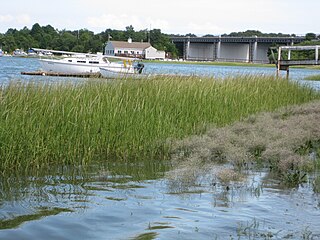
The Weymouth Back River, sometimes called Back River, is a short, primarily tidal river in Hingham and Weymouth, Massachusetts, about 10 miles (16 km) south of Boston. It arises from a number of tributaries in ponds and swamps, most notably Whitmans Pond, flows northward, and empties into Hingham Bay.
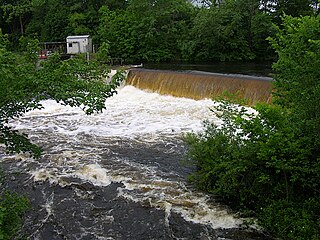
The Quinebaug River is a river in south-central Massachusetts and eastern Connecticut, with watershed extending into western Rhode Island. The name "Quinebaug" comes from the southern New England Native American term, spelled variously Qunnubbâgge, Quinibauge, etc., meaning "long pond", from qunni-, "long", and -paug, "pond". The river is one of the namesake rivers in the Quinebaug and Shetucket Rivers Valley National Heritage Corridor.

Rainworth Water is a watercourse that is a tributary of the River Maun near Rainworth, Nottinghamshire, England. It is characterised by a number of lakes, including that which forms part of the country park at Rufford Abbey. L Lake at Rainworth forms part of the Rainworth Lakes Site of Special Scientific Interest. There are two designated Local Nature Reserves along its length, one of which is also known by the name Rainworth Water. The Rainworth Water LNR is owned and managed by Nottinghamshire County Council.
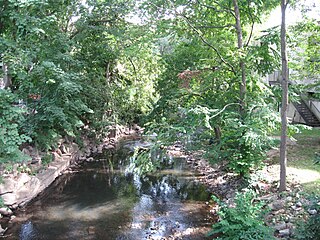
The Mamaroneck River is a freshwater stream located in Southern Westchester County, New York. The river forms in White Plains and Harrison and flows 7.3 miles (11.7 km) south through Mamaroneck Town and Village, where it empties into Mamaroneck Harbor and Long Island Sound. The name of the river comes from a local native American word meaning, "where the fresh water meets the salt water." The river flows into Long Island Sound.

Lake Innisfree is a man-made lake and former reservoir in the city of New Rochelle, in Westchester County, New York. The lake is located along the border of the neighboring town of Eastchester, and its eastern end abuts the Hutchinson River Parkway. The lake takes its name from the poem Lake Isle of Innisfree by W. B. Yeats.

Titus Mill Pond & New York State Tidal Wetlands is located at the northeastern end of New Rochelle Harbor in the city of New Rochelle in Westchester, New York. The waters in the harbor and pond flow from Long Island Sound, with tides up to eight feet in the inlet and with no fresh water stream entering into it.

Beechmont is an upscale residential community located in the northern end of New Rochelle in Westchester County, New York. Its boundaries are the town of Mamaroneck on the east, by Rochelle Heights on the south, by Huguenot Park on the west and by Forest Heights and Bayberry on the north. Beechmont is within the larger Wykagyl sub-section of New Rochelle, served by the 10804 zip-code. The United States Board on Geographic Names recognizes Beechmont as the official common name for the neighborhood, which it defines as a populated place existing within the incorporated City of New Rochelle.

The Sheldrake River is a freshwater stream located in Southern Westchester County, New York. The river forms in White Plains and flows six miles (9.7 km) south until it joins the Mamaroneck River. Approximately 1.58 miles (2.54 km) of the Sheldrake River flow through Scarsdale, 2.13 miles (3.43 km) through New Rochelle and two miles (3.2 km) through the Town of Mamaroneck.

Premium Mill-Pond is located in the communities of New Rochelle and Mamaroneck in Westchester County, New York. The mill-pond is situated northeast of Echo Bay, between the Premium Point peninsula and the mainland. It is fed by the Premium River and is separated from Echo Bay by a dam that creates a waterfall into the harbor.
Crystal Lake was a former lake in the village of New Rochelle in Westchester County, New York. It originally supplied early colonial mills with water power. It was fed by Stephenson Brook, which rises just north of Paine Lake and drains the large watershed adjacent to North Avenue from beyond Quaker Ridge Road.

Millinocket Lake is the source of Millinocket Stream in the North Maine Woods north of Baxter State Park. Millinocket Stream flows 5.5 miles (8.9 km) to Maine township 8, range 8, where it joins Munsungan Stream to form the Aroostook River. The lake extending along the border of Maine range 9 townships 7 and 8 is impounded behind a wooden dam. The dam enlarged the lake to include Little Millinocket Lake and Moose Pond by flooding adjoining bogs to store water for hydropower. The large areas of shallow flooded bog are a good habitat for fallfish, yellow perch and white suckers; but with summer water temperatures ranging from 70° near the surface to 55° in the deeper areas, dissolved oxygen concentrations become unfavorable for trout. Tributaries to the lake drain a number of small ponds to the west of the lake including Atkins Pond, Blackmore Pond, Buckley Pond, Big Caribou Pond, Little Caribou Pond, Chandler Pond, Elsie Pond, Ervin Pond, Jack Pond, Kyle Pond, Line Pond, Mathews Pond, May Pond, Little Moose Pond, Upper Moose Pond, Pretty Pond, Snowshoe Pond, and Spring Pond.
Hancock Brook is an east-bank tributary to the Saco River at Hiram, Maine. The brook originates in eastern Denmark and flows through a chain of ponds along the border between Hiram and Sebago. The narrow-gauge Bridgton and Saco River Railroad was built along the brook in 1882, and operated until 1941.
The Premium River - Pine Brook Wetlands are located on Long Island Sound in the City of New Rochelle, Town of Mamaroneck, and the Village of Larchmont in Westchester County, New York. The fish and wildlife habitat is an approximately 65 acre area including Pine Brook south of the Boston Post Road, the Premium River, Premium Mill-Pond, the northeast portion of Echo Bay, and Pryer Manor Marsh.The land area bordering the wetlands complex is predominantly moderate density residential and commercial. The portion of the habitat area within Mamaroneck and Larchmont was designated as a 'Critical Environmental Area' under the State Environmental Quality Review Act.

















